Invasive plants
reduce the Overberg’s resilience to wildfire
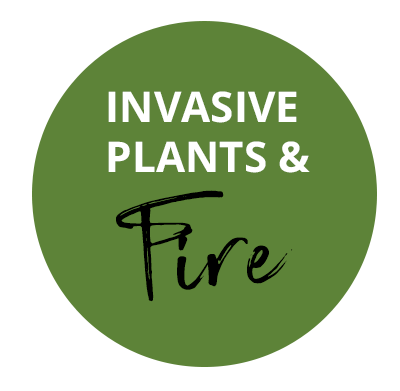
The Overberg is preparing for the next fire season as we head into the summer months following a dry winter.
Because of the increased fire risks, landowners and property owners are now encouraged to address the threats of invasive alien plants – which increase the severity and frequency of wildfires. In the Overberg, now is the final opportunity to prepare for the upcoming fire season. The fire season starts in November in the Overstrand and December in the rest of the Overberg.
“Invasive aliens are a huge wildfire threat in the Overberg”
According to Chris Martens of the Fynbos Trust and board member of the Greater Overberg Fire Protection Association (goFPA), there’s a close connection between fire and invasive plants. “Invasive aliens are a huge wildfire threat in the Overberg. Fires burn hotter and more often in our fynbos landscapes and the urban interface because of these plants. They change fire behaviour and they alter fire regimes.”
For those landowners who have cleared invasive plants, these wildfires can also undo all the work and money spent on clearing. That’s because fires stimulate the seed of invasive species, especially the likes of Port Jackson (Acacia saligna) and Long-leaf wattle (Acacia longifolia). Chris says, “These seeds can remain in the soil for a hundred years and more, and will always outcompete indigenous fynbos after a fire.”

Using fire
to manage
invasive species
But there is a flip side to the relationship between fire and alien plants: fire can also be used as a potential tool to manage aliens.
This provides an opportunity for landowners to use fire to help manage their invasive plants – but this needs to be done with careful
and clever planning, and should never be done in an ad hoc way.”
The Greater Overberg Fire Protection Association is now teaming up with the Fynbos Trust and other partners to encourage landowners to start addressing the threat of invasive plants through fire. Mitch Afrika, Extension Officer of the goFPA says the first step is to ensure farmers and property owners have the right information to develop an integrated fire and invasive alien management plan.


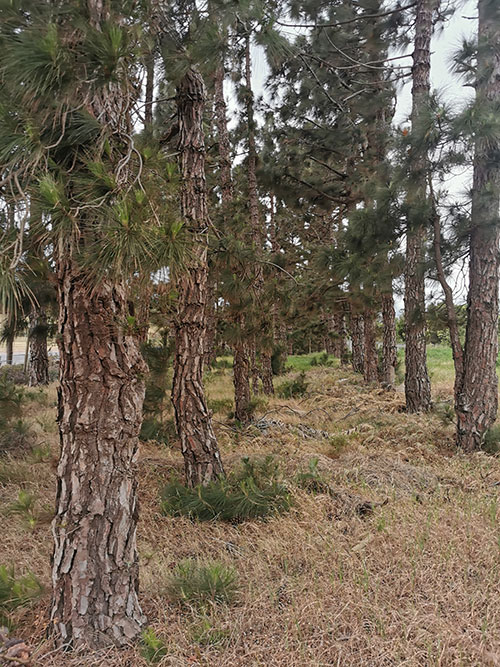
The steps to take to compile
the plan
He says, “Landowners should identify management units where these integrated activities can take place. These should be chosen based on things like the size of the area, the fire history, the ability to control fires, and whether it’s close to infrastructure. They could even look at conservation priority areas, such as rivers and wetlands, to increase water flow once the plants are removed.”
Know what aliens you have and how much you have
Once the management units have been selected, landowners should carefully plan their next steps. Mitch says, “Know what aliens you have and how much you have. Fire breaks need to be in place. And only then can planned burns be undertaken, with follow up invasive alien clearing ready to take place when the invasive seeds germinate.”
Mosaic of different fynbos veld ages
He says the aim of planned burns is to have a mosaic of different fynbos veld ages across the property. This not only helps the natural area, but also supports fire fighters to douse wildfires when the fire reaches the younger veld. “The tip for landowners is to plan management activities in a way that allows fire to remove invasive plants cost-effectively.”
Fires become harder to extinguish as
alien plants flourisH
Chris adds that managing invasive plants and wildfire not only reduces the threat to infrastructure, especially in the Overstrand district, where houses border the natural fynbos landscapes. It also reduces the severe impact that fires have on fynbos landscapes. “While fynbos is a fire-driven ecosystem, too frequent fires have devastating results. They can lead to plant extinctions. Fynbos wildlife has also evolved with fire over the last four million years but unseasonal and short-rotation burns can destroy much of the wildlife,”
The Overberg District Municipality’s Chief Fire Officer Reinard Geldenhuys warns that as invasive plants continue to overwhelm the natural landscapes, the dangers of wildfires increase. “Every year we see how these alien species make it more difficult for fire fighters to extinguish fires, and all the more dangerous for our teams and for people living in areas that are burning. If we can’t start to bring these invasions under control, we face even tougher fire seasons in the near future.”
Tips to integrate invasive plants and fire management
Fire and invasive plants are intricately linked in the Overberg. How?
Because invasive plants are a big threat to us during fire season. They burn hotter and more often than our indigenous vegetation. They change the way fire behaves. And they stimulate invasive plant seeds to grow post-fire, which outcompetes our fynbos.
But at the same time, prescribed burns are an important tool to manage invasive plants – if used with proper planning.
The goFPA has compiled easy-to-follow steps for landowners and Overberg residents, to help address the threat of invasive plants.
1. There are 2 key principles to managing invasive plants:
- Take action early – it’s cheaper and easier than tackling severe infestations
- And then follow up and maintain those areas already cleared, to protect those investments made in clearing the land of alien plants.
2. You need an invasive alien clearing plan
Step 1: Survey the area
– understand what alien plants you have, and where they are
Step 2: IDENTIFY UNITS
break the property down into sensible units, a block of land that will respond in a similar way to a management action
Step 3: Plan your Actions
decide on the management actions you’ll need in each unit, for example a controlled burn
Step 4: CaLCULATE THE COST
– if you know the size of the unit, the density of the invasive plants and the control methods, you can work out what the work will cost you.
For more info on how to develop a plan, check this practical guide to managing invasive plants, created by WWF South Africa and co-authored by goFPA Board Member Chris Martens:
3. Prioritise areas to clear, and integrate this with controlled burns. Here are a couple of tips on where to focus your efforts:
- Target emerging species before they set seed
- Focus on follow-up treatment first
- Target areas where wildfires threaten houses, infrastructure or important ecological areas
- Choose low-density invasions first
- Clearing should start from the highest point and move downwards
- Work from the outside inwards
- Work horizontally along contours to prevent soil erosion
- Focus on rivers, streams and wetlands
- Work with your neighbours to plan clearing and manage invasions.
4. Tree Tips

Pine trees
We’re plagued by many different species of invasive alien plants in the Overberg. And each species needs a different approach. For example, pines and hakea are VERY flammable. Because of their high resin content, they burn hot – whether it’s dry or wet. It’s difficult to extinguish wildfires in fynbos where these invasive plants occur. And that’s a big danger to valuable crops and nearby infrastructure, including houses on the edge of town.
In order to manage them, it’s best to fell the trees and then burn them 18 months to 2 years after (with a burn permit), to take out all the small regrowth before they cone again. By doing this, you’ll deplete the seed store. Bear in mind that when the biomass is stacked, heat from a fire will be concentrated on these patches, which could scorch the soil and hamper the recovery of the fynbos.
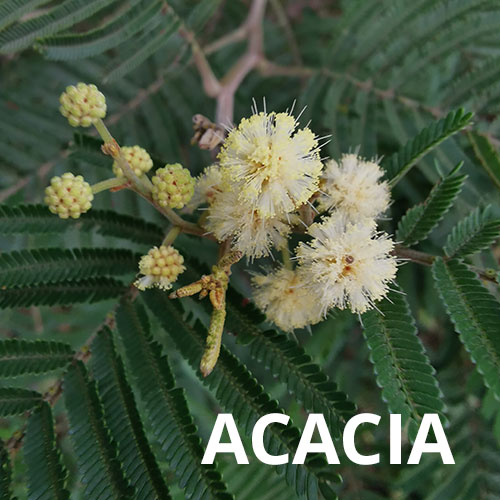
Acacia species
such as Port Jackson and Long-leaf Wattle are fire-driven (like fynbos), so many of them, especially Acacia cyclops (better known as Rooikrans), burn easily and fast. And that makes it difficult to extinguish these fires on a hot, dry, windy day.
But fire is also a good tool to manage acacia species. Here’s a tip for landowners: After a burn, acacias regenerate in a carpet from seed. If this growth is successfully treated with herbicide, then landowners would have significantly reduced this seed store – which can lie in the soil for up to 100 years if not stimulated to germinate.
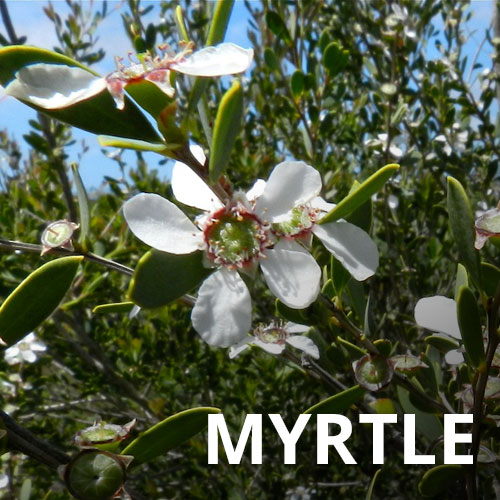
Myrtle
Where farmers have dense stands of large Australian myrtle (𝘓𝘦𝘱𝘵𝘰𝘴𝘱𝘦𝘳𝘮𝘶𝘮 𝘭𝘢𝘦𝘷𝘪𝘨𝘢𝘵𝘶𝘮), it’s very difficult to burn these – especially in cooler weather. So it’s best to burn these in a controlled way during the hot, dry months (early autumn is invariably the best time). Myrtle doesn’t coppice. But fire does trigger the seedbank, like acacia species. So it requires a particular management approach.
Landowners could consider burning dense stands of myrtle first (with the right permit, and in the right weather). After the controlled burn, clear all the trees that survived. And then the myrtle plants that sprout should be cleared – either by handpulling them or via herbicide. While the herbicide costs will be notable in the first year or two, by the third year this will reduce dramatically – as will the myrtle invasion.
5. Maintain the Gains
If natural land covered in invasive plants burns in a wildfire, be sure to try to maintain the gains made. Get your own farm team to clear the emerging invasive plants. Or employ a contractor and his/her team. Either way, they should have the necessary equipment, the right personal protective gear and must adhere to safety regulations.
If you need help finding a team in the Overberg, chat to Wild Environment Solutions (WEBS). More here.
6. It’s ideal to have an integrated plan in place for fire and invasive alien plant management. In this plan, you need to identify the fire management units that can effectively be burnt through prescribed or ecological burns.
You’ll choose these fire units based on:
- Topography (the slope, weather conditions, fire behaviour)
- Whether it’s practical, defendable and the cost
- Whether it’s a manageable size
- And the ignition history of the area.
But don’t burn if you’re not able to clear the invasive seedlings that emerge, as you could make your infestation worse.
7. Ask yourself these questions to create an invasive-plant inventory:
- Where are your invasives, how dense are the stands, when did you last clear, and what biocontrol is already in place?
- What infrastructure is threatened by wildfires spurred on by these plants?
- And what biodiversity is threatened?
- Also, what’s the fire management history of the area?
The answers to these questions will help you to schedule your management activities.
8. How do landowners schedule clearing activities and choose where to focus your efforts first?
Use the info you compiled during your inventory. Then capture this in your annual plan of operation (or APO). Remember to include the costs. This shows you easily where to focus your work.
Here’s an example of your APO:
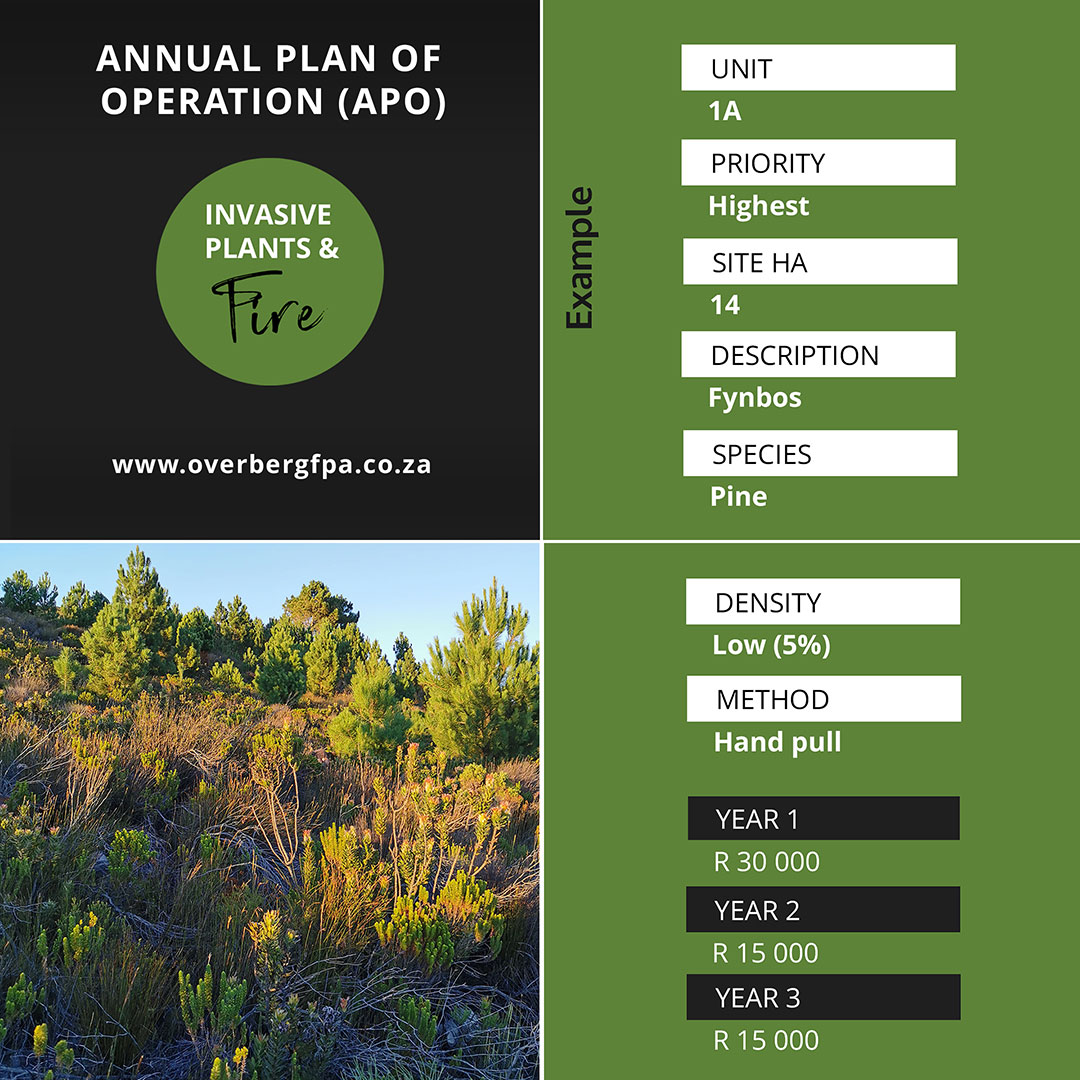
9. plan your activities
If our first 8 steps have shown you anything, it’s that when you integrate fire and alien clearing, you must plan your activities.
Only then does the actual work on the ground start: like preparing your firebreaks for a controlled burn. Then undertake the burn during the ecological window (and with burn permits in place). And finally employ a team to follow up after the fire, to remove the invasive seedlings.
10. BIOMASS
When you cut down invasive plants, the remaining biomass can become a huge wildfire hazard. Landowners need to factor this risk in during your planning – depending on what you intend to do with the biomass.
If the plan is to burn your biomass during a controlled burn, then consider the following:
- Burn when you’re allowed to, with the right burn permits in place.
- If the biomass is on natural land, burn when it’s ecologically the right time.
- Heaps of burning biomass could scorch the soil below it, so with species such as pine and hakea, it’s best not to stack the biomass.
- Too-frequent fire on fynbos and renosterveld is extremely damaging. Chat to the experts to burn lands when they need it (around every 10-20 years, depending on the vegetation).
11. Then keep accurate records.
If you capture and keep the info of what you cleared, when you cleared it, and when you burnt it, you can use this info to plan future activities. This is especially helpful when you plan your integrated fire and alien clearing on your farm.
12. You’re not alone in this struggle against invasive alien plants. So wherever possible, landowners should collaborate with others for greater impact.
Talk to your neighbours, and fellow Fire Management Unit members and leaders – to plan combined invasive alien and fire management activities. Chat to the goFPA team to give you ideas where you might need it. And connect with organisations already doing this work in the Overberg, like the ABI Ecological Infrastructure Working Group.
(The tips provided here are meant to serve as guidance – but each landowner should consider his or her unique situation and risks before deciding on the best course of action. Check out WWF South Africa’s practical guide to managing invasive plants)

